This beautiful compact form of French lavender has been selected for it's rich fragrance and great tolerance for humid conditions.
SuperFrenchTM Lavender has been bred in Australia by Paradise® Plants. It is at its best in Spring, but will continue to flower all year round! With highly fragrant mauve blue flowers held on short strong stems above soft grey-green foliage, SuperFrenchTM Lavender is ideal for the herb garden, landscaping & pots. Perfect for picking as cut-flowers, dried indoor decoration or potpourri.
Super FrenchTM has been selected in hot, humid conditions and is therefore more tolerant of heat and humidity than other French Lavenders, this trait combined with the same heat resistance and drought tolerance of regular french lavender Super French can be grown in all but the coldest parts of Australia. May struggle in the tropics.
Container displays
Small informal hedges
Providing colour in Xeriscapes
Encourages butterflies, bees and other beneficial insects and birds
Cut flowers
Pot Pourri
Herb Gardens
- Borders
- Containers
- Exotic
- Foliage
- Fragrance
- Scented Flowers
- Shrubs
- Standard
Full sun
Soil must be open and free draining.
Super French lavender is intolerant of heavy or waterlogged soils. Improve drainage if necessary using well rotted organic matter or raised beds.
Space plants 30cm apart for a hedge or border
Dig the planting hole twice the width and depth of the pot that is being planted. Backfill with topsoil that has been improved with organic matter. Make sure that the rootball sits no lower than the surrounding soil.
Lavender is very drought tolerant once established however moderate watering for the first few months after planting will encourage stronger more vigorous plants. Watering directly on the soil rather than the foliage can help to reduce the possibility of fungal problems occurring.
Mulching is important to protect surface roots from extremes of temperature and helps to retain soil moisture. Mulch should be applied over the soil to 10cm deep. Keep mulch 5cm-10cm away from the base of the plant so as not to impede airflow which may lead to an increase in pest and disease problems.
Lightly trim after flowering to remove spent blooms and to maintain shape.
Fertilise in spring and summer using a high quality complete fertiliser.
 Look out for this label in all good garden centres.
Look out for this label in all good garden centres.